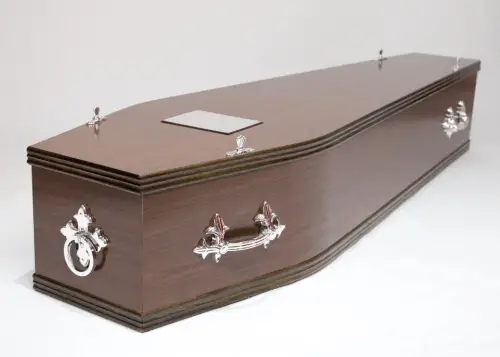Caskets and coffins are specialized boxes designed for one purpose: to serve as a receptacle for a deceased body.
But while these terms are commonly used interchangeably, there are major differences between the two.
Summary Table
| Casket | Coffin |
| The term “casket” was originally used to describe a decorative box used for keeping precious items such as jewelry | The term “coffin” was coined from the Old French term cofin, which means little case or basket |
| Rectangular | Hexagonal |
| Not form-fitting | Form-fitting |
| Designed with a hinged lid | Designed with a removable lid |
| Typically made of wood or metal | Made of wood |
| More expensive | Cheaper |
Definitions

A casket is a funerary box used to hold the remains of a deceased person specifically for viewing or burying purposes.

A coffin, on the other hand, is a custom-made box built for either viewing or burying a corpse.
Casket vs Coffin
Since they function quite similarly, it can be easy to assume that there is no difference between a casket and a coffin, but there actually is. Below are some of the factors that set the two apart.
Term Etymology
Before the mid-19th century, the term “casket” was originally used to describe a decorative box used for keeping precious items such as jewelry. As many people looked for ways to alleviate the grieving process caused by death, the word soon bore different associations. The casket, which was popularly known as a “jewelry box,” later described a four-sided funerary box used to hold something even more precious than silver or gold – a loved one’s remains. Caskets quickly rose in popularity because it appeared less melancholic than the traditional form-fitting coffin.
Comparatively, the word “coffin” was coined from the Old French term cofin, which means “little case or basket.” The earliest form of this term was expressed in Linear B syllabic script that reads ko-pi-na, a Mycenaean Greek word that has a similar meaning. As the word evolved, the term “coffin” was attested as an English word in the year 1380.
Shape
If there’s a significant difference between the two, it’s their shape. A traditional coffin is a hexagonal box designed to fit the human body. It is wider at the top and narrower at the bottom part, which is purposely built for the placement of the legs and feet.
A casket, by contrast, is not form-fitting. A rectangular box commonly designed with a split lid, a casket has the same width at the top and bottom.
Because it is not shaped like a human, most mourners find it more comforting than a coffin.
Lid
While designs vary depending on the construction, most coffins are built with a removable lid that can be lifted off for viewing purposes. A casket, by contrast, comes with a hinged lid.
Materials
Unlike a coffin which is typically made up of wood, a casket is categorized as either a wooden or a metal casket. The materials used for building a casket all depend on individual preferences, but usually, construction requires the use of a combination of different types of wood (e.g., mahogany or oak) and metal (e.
g., stainless steel).
Price
The shape and the materials used in building the two greatly affects pricing. Since a coffin is designed with a narrower side, it uses fewer materials and is, therefore, less expensive than a casket.





